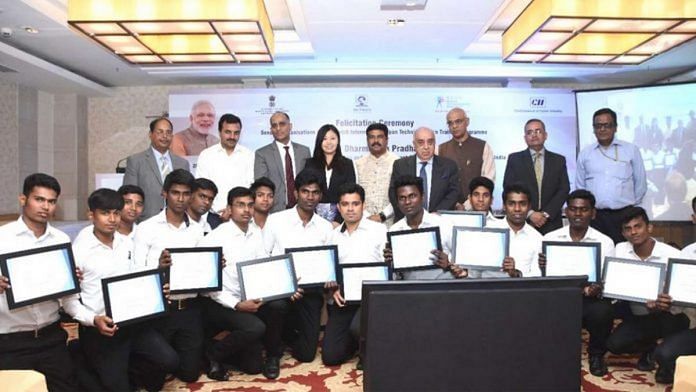New Delhi: In 2017, the Union skill development ministry had started a Technical Intern Training Programme (TITP) in association with Japan. The minister at the time, Dharmendra Pradhan, had said in the next three to five years, about three lakh Indian youth will be provided internships in Japan, and of these, about 50,000 could get employed in Japan itself.
Two years on, the total number of interns sent to Japan under the TITP framework is 54, which will increase to 59 by the end of August 2019. ThePrint has obtained these figures from the body responsible for implementing this programme, the National Skill Development Council (NSDC).
The first two batches
The first batch of 17 youth under the TITP was sent to Japan in July and September 2018. Aged between 23 and 27 years, 12 of these 17 interns were from economically-backward families of southern Tamil Nadu. According to the ministry’s official press release, the interns received an incentive amount of Rs 65,000 per month.
The next batch, also consisting of 17 youth, was sent to Japan in January 2019. Notably, for the first time, five of these youth were sent for internships in the healthcare industry. Japan is witnessing an explosion in the population of the elderly, and the healthcare industry has expanded quickly to meet this demand.
The interns in this batch are being paid incentives in accordance with the standard rates in Japan — the NSDC states the salary in this sector can go up to about Rs 1 lakh per month.
Also read: Skill India ministry needs to find itself 1 office before it can help Indians find jobs
Pre-departure training
“Many organisations working with us teach these youth Japanese language, culture and behaviour for about six to 18 months,” an NSDC official told ThePrint.
According to the ministry, at the moment, around 500 youth are being given this kind of pre-internship training.
“It is important to impart this kind of preparation so that these interns do not face any kind of hardships in Japan. We also take their feedback from time to time,” the official said on the condition of anonymity.
Lack of interest
An official of the skill development ministry, who also wished to remain anonymous, said the low numbers so far aren’t due to a lack of effort on the government’s part.
“It is not that the government is not making a serious effort. Actually, the interest among the youth towards this programme is quite low, for several reasons,” the official said.
“Japanese is one of the toughest languages in the world, and they also need to imbibe the culture and behavioural practices, which can be quite depressing for the youth. It is tough to work in a foreign country if you have to act and behave like a native.
“Also, in India, we do not have any special options to train them in caring for the elderly.”
TITP partnerships with other countries
Japan had initiated the TITP in 1993, saying it would benefit developing countries because interns would be provided skill and training in agriculture, construction and manufacturing.
So far, 74.5 per cent interns under this programme have come from China and Vietnam. In 2016, there were over 2.11 lakh interns in Japan.
In the last few years, India has also been working to strengthen trade and commerce with Japan.
Also read: India, Japan join hands to build infrastructure in other countries






